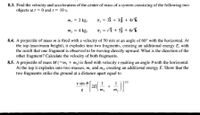
Elements Of Electromagnetics
7th Edition
ISBN: 9780190698614
Author: Sadiku, Matthew N. O.
Publisher: Oxford University Press
expand_more
expand_more
format_list_bulleted
Concept explainers
Question
Number 8.7 and 8.8 please and 8.3

Transcribed Image Text:8.3. Find the velocity and acceleration of the center of mass of a system consisting of the following two
objects at t = 0 and 1 = 10 s.
m, = 2 kg,
r, = 2î + 3j + 41°k
m, = 4 kg,
r, = 11 + 5j + 62°k
%3D
8.4. A projectile of mass m is fired with a velocity of 50 m/s at an angle of 60° with the horizontal. At
the top (maximum height), it explodes into two fragments, creating an additional energy E, with
the result that one fragment is observed to be moving directly upward. What is the direction of the
other fragment? Calculate the velocity of both fragments.
8.5. A projectile of mass M (=m, + m2) is fired with velocity v making an angle 0 with the horizontal.
At the top it explodes into two masses, m, and m,, creating an additional energy E. Show that the
two fragments strike the ground at a distance apart equal to
v sin 0
1
+
| 1/2
m,
m2

Transcribed Image Text:332
System of Particles: Conservation Laws and Collisions
Chap. 8
8.6. If a projectile explodes at the top (maximum height) with an additional energy E, under what cir-
cumstances will one of the fragments land at the starting position?
8.7. A fire boat draws water from a bay through a vertical inlet and sprays it out at a rate of 10 m/s. The
diameter of the nozzle of the fire hose is 20 cm. Calculate the horizontal force from the propellers
necessary to keep the boat stationary. The density of water is 1020 kg/m³.
8.8. A bucket of 0.5 kg is placed on a spring scale and water is added to it from a height of 2 m at a rate
of 5 ml/s. Find the scale reading as a function of time.
8.9. A chain of length L and mass M is held vertically so that the bottom of the chain just touches the
horizontal table top, as shown in Fig. P8.9. If the upper end of the chain is released, determine the
force on the table top, as the function of the length of the chain above the table top, while it is falling.
Expert Solution
This question has been solved!
Explore an expertly crafted, step-by-step solution for a thorough understanding of key concepts.
Step by stepSolved in 2 steps

Knowledge Booster
Learn more about
Need a deep-dive on the concept behind this application? Look no further. Learn more about this topic, mechanical-engineering and related others by exploring similar questions and additional content below.Similar questions
- A hole is to be drilled as shown by the circle. Using the part geometry shown below, indicate on the part sketch where locator(s) should be positioned according to the 3-2-1 principle. Use dashed lines to indicate locators on hidden surfaces. Also indicate where clamping force(s) should be applied using arrows. Use the minimum number of clamping forces.arrow_forwardx=-2-5-6/2marrow_forwardThe figure shows the chain drive of a bicycle. How far will the bicycle move if the pedals are rotated through 180°? Assume the radius of the bicycle wheel is 12.7 inches. The bicycle will travel approximately (Round to the nearest tenth.) in. C -1.95 in 4.21 inarrow_forward
Recommended textbooks for you
 Elements Of ElectromagneticsMechanical EngineeringISBN:9780190698614Author:Sadiku, Matthew N. O.Publisher:Oxford University Press
Elements Of ElectromagneticsMechanical EngineeringISBN:9780190698614Author:Sadiku, Matthew N. O.Publisher:Oxford University Press Mechanics of Materials (10th Edition)Mechanical EngineeringISBN:9780134319650Author:Russell C. HibbelerPublisher:PEARSON
Mechanics of Materials (10th Edition)Mechanical EngineeringISBN:9780134319650Author:Russell C. HibbelerPublisher:PEARSON Thermodynamics: An Engineering ApproachMechanical EngineeringISBN:9781259822674Author:Yunus A. Cengel Dr., Michael A. BolesPublisher:McGraw-Hill Education
Thermodynamics: An Engineering ApproachMechanical EngineeringISBN:9781259822674Author:Yunus A. Cengel Dr., Michael A. BolesPublisher:McGraw-Hill Education Control Systems EngineeringMechanical EngineeringISBN:9781118170519Author:Norman S. NisePublisher:WILEY
Control Systems EngineeringMechanical EngineeringISBN:9781118170519Author:Norman S. NisePublisher:WILEY Mechanics of Materials (MindTap Course List)Mechanical EngineeringISBN:9781337093347Author:Barry J. Goodno, James M. GerePublisher:Cengage Learning
Mechanics of Materials (MindTap Course List)Mechanical EngineeringISBN:9781337093347Author:Barry J. Goodno, James M. GerePublisher:Cengage Learning Engineering Mechanics: StaticsMechanical EngineeringISBN:9781118807330Author:James L. Meriam, L. G. Kraige, J. N. BoltonPublisher:WILEY
Engineering Mechanics: StaticsMechanical EngineeringISBN:9781118807330Author:James L. Meriam, L. G. Kraige, J. N. BoltonPublisher:WILEY

Elements Of Electromagnetics
Mechanical Engineering
ISBN:9780190698614
Author:Sadiku, Matthew N. O.
Publisher:Oxford University Press

Mechanics of Materials (10th Edition)
Mechanical Engineering
ISBN:9780134319650
Author:Russell C. Hibbeler
Publisher:PEARSON

Thermodynamics: An Engineering Approach
Mechanical Engineering
ISBN:9781259822674
Author:Yunus A. Cengel Dr., Michael A. Boles
Publisher:McGraw-Hill Education

Control Systems Engineering
Mechanical Engineering
ISBN:9781118170519
Author:Norman S. Nise
Publisher:WILEY

Mechanics of Materials (MindTap Course List)
Mechanical Engineering
ISBN:9781337093347
Author:Barry J. Goodno, James M. Gere
Publisher:Cengage Learning

Engineering Mechanics: Statics
Mechanical Engineering
ISBN:9781118807330
Author:James L. Meriam, L. G. Kraige, J. N. Bolton
Publisher:WILEY